How Do You Know Which Way a Computer Fan Blows
Fans areeverywhere it seems! They're critical for everything from cooling a computer'south CPU to keeping us comfy or even helping with plant grow rooms. It'south honestly amazing how versatile they are.
But do you know how to tell which way a fan blows? If non, I'd love to bear witness yous how. Once y'all've got the basics down information technology's not hard at all!
In this mail service, I'll share with you the details you need to practice then. Not only that, I'll help you amend understand how fans work forth with sharing some helpful facts to know.
Contents
- Infographic – Fan facts and airflow basics
- How to tell which mode a fan blows – iii basic methods
- ane. Fan blade bending and rotation management
- An everyday case
- 2. The type of fan and its intended utilise
- iii. Fans that accept directional markings
- Did y'all know? Great fan facts
- i. They're very energy-efficient vs. air conditioning
- 2. Fans cool you…only don't actually absurd the air!
- iii. They're great for white noise
- Summary
- Boosted reading
Infographic – Fan facts and airflow basics
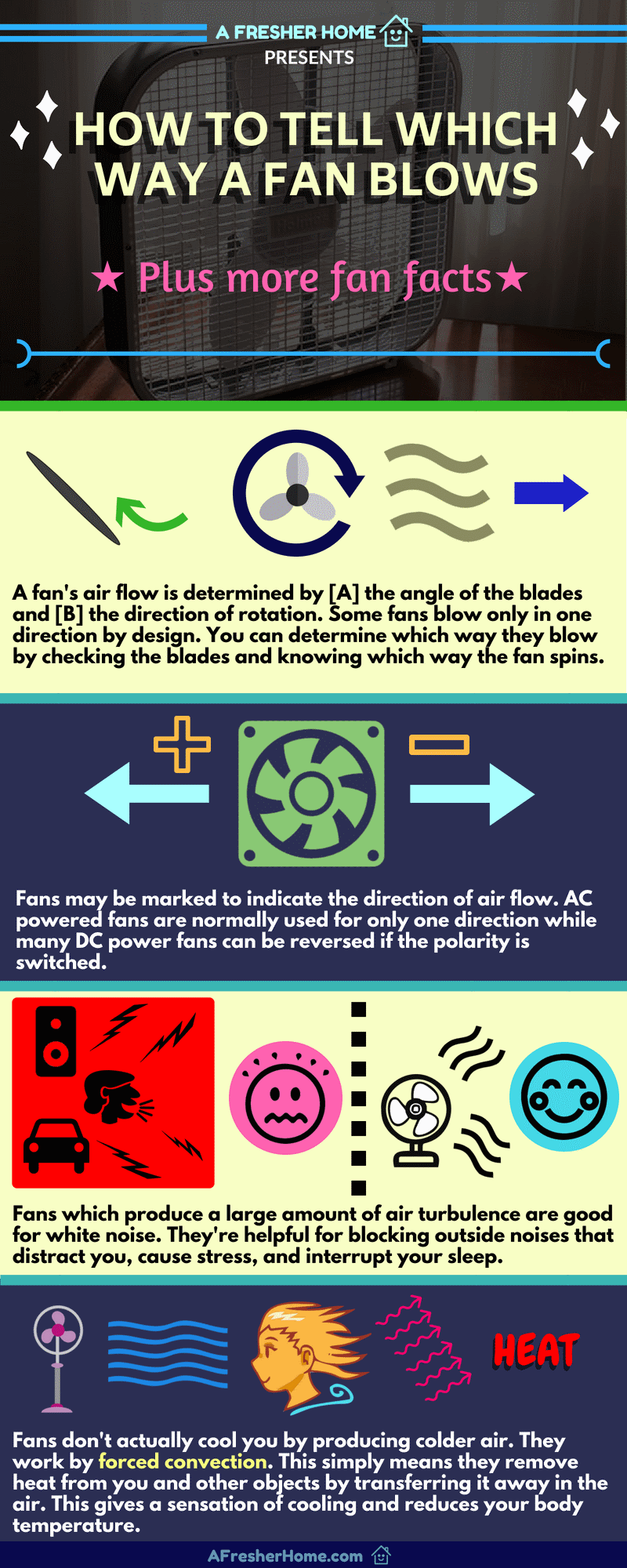
How to tell which manner a fan blows – 3 basic methods
The groovy news is that generally speaking information technology'due south easy to tell fan air direction if you know what to look for. Because of how they work (and how most are designed) at that place are slap-up clues to help.
It also depends strongly on the fan'southward intended utilize as well. Here are iii ways to tell which mode a fan blows:
- Using the fan angle and rotation direction
- By the type of fan and its intended use
- Fan directional markings
i. Fan blade angle and rotation direction

The management a fan blows air is always determined by (A) the shape of the blades (sometimes chosen propellers) and (B) the direction they turn. If a bract is angled downwardly and the fan turns in the same direction as the blade bending, it will blow forward. Too, if the blade is angled down and the fan turns the opposite direction, the opposite is true. Air will accident in the other management (towards the back).
These ii characteristics of a fan are probably the easiest and most common way to tell which way it blows.
That's because a fanalways has the same basic design in ane grade or another: fans apply angled and slightly curved blades to cut through the air and force information technology forward or backward depending on the direction of rotation.
Here's an animated prototype I've put together to help evidence this.

In this epitome you tin run across exactly what I'k describing: the fan is rotating in the same management as its blades which are angled downwards. This causes air to blow upwardly (to the front of it).
If the fan's direction is reversed, the air volition go the reverse management as it would be forced downwards (towards the rear) instead of the front.
An everyday example
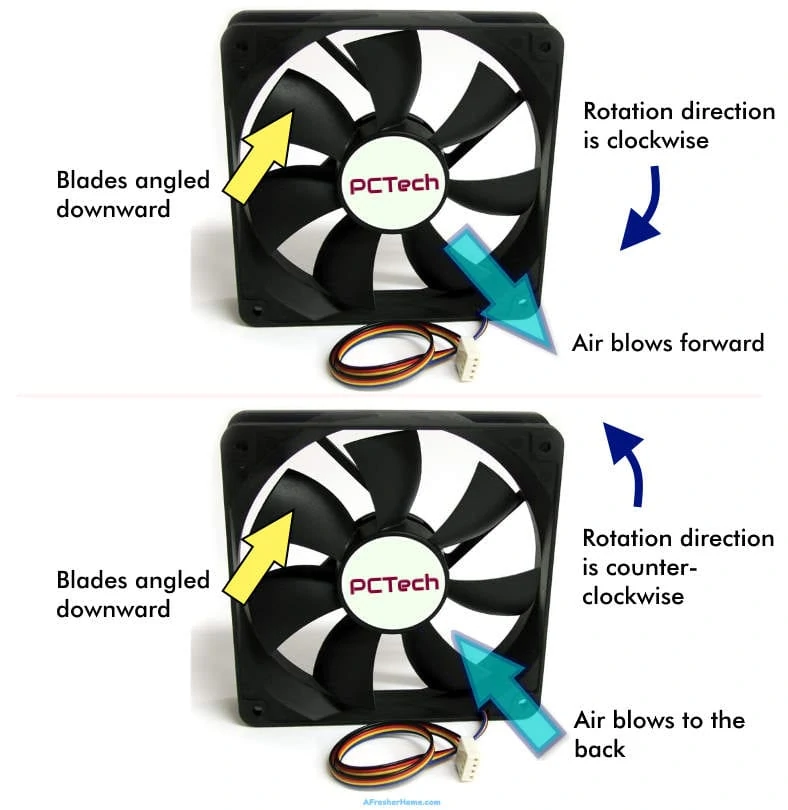
Here'southward a great example of how to decide which mode a fan blows. This is a common small fan powered by direct current (DC) and used for many electronics cooling applications. Looking at the fan, nosotros can come across the bending of the blades and we know that well-nigh of these rotate clockwise (the same direction as a clock). Therefore, unless the power polarity is reversed, it volition blow air forward.
The paradigm in a higher place is a great case of a common fan you might run across. Past looking at the fan and knowing which style the blades are angled, and knowing that it normally turns clockwise, I can see that it will blow air frontwards.
Of form, if for some reason the fan rotates in the opposite direction (unbeknownst to me) the air would exist diddled the other style.
two. The type of fan and its intended apply

Fans generally only come up in a few bones designs, most of which are axial or centrifugal types. Centrifugal fans normally only blow in the direction of the outlet as shown, while centric fansmay be reversible in some cases.
While many variations of fans be, nearly all fall into just a few bones categories as the most important pattern principles are the same.
A fan's direction is often fixed and largely determined by what information technology was designed to do:
- Airplane propellers and jet engines e'er force air from the front to the rear
- Ceiling fans are unremarkably used for blowing air downwards into the room just can be reversed to force air to the ceiling
- High-speed cooling fans of the centrifugal type blow forward
- Home cooling fans normally blow forward and can't be inverse
- Ventilation fans are mounted in a wall, window, or other assembly and spin to accident air out of a edifice

Most mutual home fans used for cooling like this No products constitute. are designed to blow but ane direction: forwards. You can encounter the blade shape in the picture which gives a clue virtually this equally well. You'll need to rotate the fan 180° to alter the air direction.
Fans powered past alternate current (Ac) such as common household 120V or 220V fans typically tin only accident forward. However, direct current (DC) fans are often reversible.
That's because DC power tin can alter the operation of the electric motor within the fan, causing the blades to spin in the opposite management and strength air to the rear.
3. Fans that have directional markings
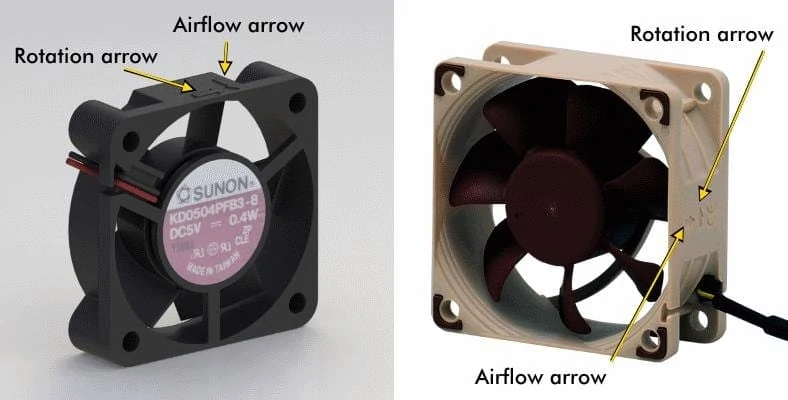
An example of some common fans with markings to show which way air blows. In both cases, there are two arrows: i to bear witness the management of rotation, and one to show the airflow direction. Left: This fan is the virtually mutual blazon, every bit information technology tin be mounted backward if you need to reverse airflow. Correct: This fan is less mutual but does have some uses where the airflow going to the rear is important.
While information technology's non equally mutual, some fanspractise have a marking indicating which style they blow. If you're lucky enough to find that on ane, information technology makes it fifty-fifty easier to tell!
Ordinarily, y'all'll near likely detect this on full general-purpose fans similar small DC powered fans for electronics cooling. Still, from time to fourth dimension it can be constitute on others.
It'southward actually handy to remember method #ane in a higher place. That manner you can tell which fashion a fan blows nearly 100% of the time and especially if one isn't marked with arrows or a label to tell y'all.
Did yous know? Dandy fan facts
Fans are typically non very expensive merely can be very cost-effective in many applications. They're helpful for many common uses and problems, merely there are some things you might not know almost them.
Hither are some keen fan facts to know. Be certain you're using fans to better your quality of life (and salvage coin) as much every bit possible!
i. They're very energy-efficient vs. air conditioning
 Electric fans can run and help cool you lot and your room with up toan astonishing threescore% less power than air conditioning units!
Electric fans can run and help cool you lot and your room with up toan astonishing threescore% less power than air conditioning units!
That's considering fans don't need near as much electric current to piece of work. Air-conditioning (AC) units not just have to power an electric fan but besides an free energy-thirsty refrigerant compressor motor. That adds up over time!
two. Fans cool you…just don'tactually cool the air!

Fans tin make you feel cool and comfy as well equally cycling the room'south air to forestall heat from edifice upwardly. Just did yous know? They don't piece of work past spooky the air. They piece of work off of the principle known equally forced convection.
Here's a cool (no pun intended!) fact – electrical fans don't absurd a room by dropping the temperature. Air conditioning units practise and then past removing heat from the air.
Fans create a cooling effect by the principle known equally forced convection. That just ways that fans cool your body and your room by forcing air across surfaces, removing heat from yous into the nearby air.
They also go along air circulating within a room, offer a continual effect that makes y'all more comfortable.
Because of that, it's important to have a well-designed fan with nifty airflow and specially one with an oscillation feature to motion back and along, covering a large area in a room.
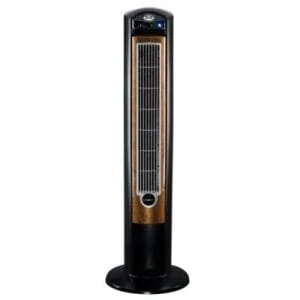
Tower fans are specially designed to produce a comfortable airflow. They're different from other types every bit they produce a tall, vertical area of air and oftentimes oscillate (motility side to side) to cool a room.
Tower fans like No products found. are an excellent case of this.
3. They're keen for white noise
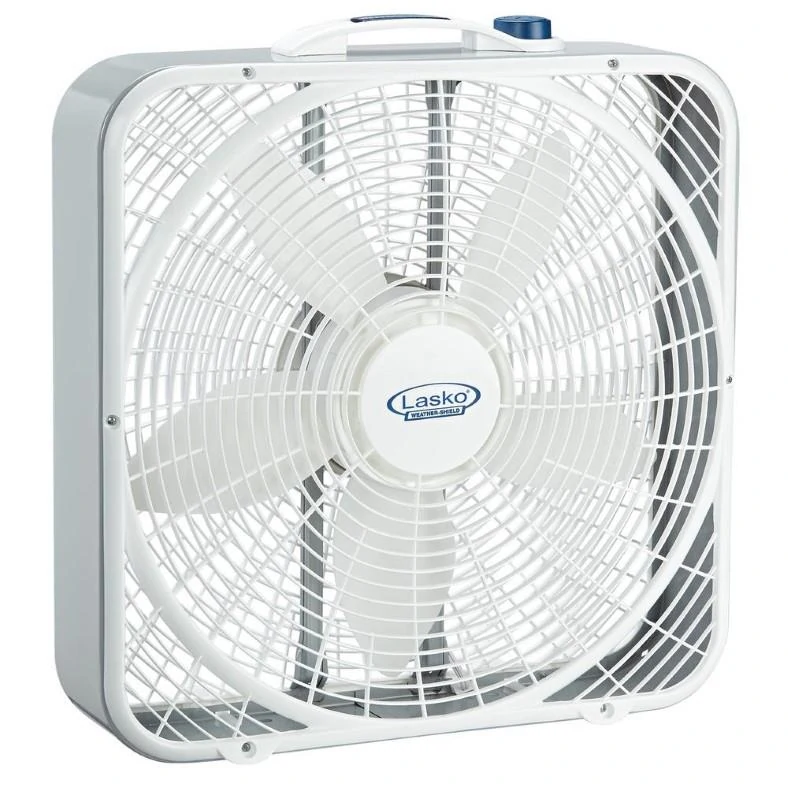
A uncomplicated but classic box fan like No products found. produces a soothing and calming "white noise" that tin can ameliorate your quality of life. A side effect of how they work, the noise "masks" (covers up) outside noises like your neighbors, traffic, people talking, and more. It'southward a nifty and cost-effective manner to help you focus, relax, or sleep ameliorate.
Fans are besides very helpful in some cases for blocking outside noises that crusade u.s.a. stress and interrupt slumber, studying, or working.
Models that produce a very high airflow rate and introduce a lot of turbulence most them as a side effect tin produce a large amount of soothing white noise. Box fans are specially helpful for this.
If you're interested in finding out more, here's a great post with some of the best box fans for white noise you lot tin can purchase.
Summary
Being able to tell which way a fan blows isn't difficult in virtually cases. Just call up these basic tips:
- Await for directional arrows
- The ability source type (AC or DC) and intended apply
- You lot can near ever tell from the blade bending and rotation
Do you have suggestions, more questions, or wish I covered some topics in more detail? Feel complimentary to drop a comment below or reach out to me.
Additional reading
Want to know how much energy a fan can relieve? Find out how much electricity an air conditioner uses vs a fan here.
Need to cool out? Hither's a helpful post with some of the best tower fans you lot'll find today.
palmieriprood1944.blogspot.com
Source: https://afresherhome.com/how-tell-which-way-fan-blows/
0 Response to "How Do You Know Which Way a Computer Fan Blows"
Post a Comment